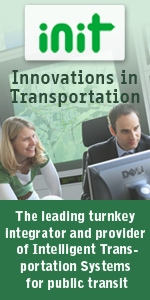

| In This Issue |
| » NEWS HEADLINES |
| » COVERAGE OF THE 2010 APTA RAIL CONFERENCE |
| » COMMENTARY |
| » PEOPLE ON THE MOVE |

The classifieds in this issue offer employment at transit and government agencies throughout North America!
| NEWS HEADLINES |
U.S. Mayors’ Report on High-Speed Rail
The introduction of U.S. high-speed rail will serve as a catalyst for economic growth at the city and regional levels, incorporating the creation of new jobs, improved market access, greater connectivity, and savings in commute times.
That is the message of The Economic Impacts of High-Speed Rail on Cities and their Metropolitan Areas, a report released June 14 by the U.S. Conference of Mayors (USCM), focusing on four representative metropolitan areas: Los Angeles, Chicago, Orlando, and Albany, NY.
“In all four cities, the introduction of high-speed rail services will significantly increase jobs, wages, business sales, and value-added Gross Regional Product,” the report states. “The potential long-term economic impact of proposed high-speed rail service will grow over time as service is fully implemented and savings in travel time, expenses, and congestion reduction are realized.”
The report lists five major benefits common to all four metropolitan areas. High-speed rail service can:
* Help drive higher-density, mixed-use development at train stations;
* Increase business productivity through travel-efficiency gains;
* Contribute to expanding visitor markets and generating additional spending;
* Broaden the regional labor market by transporting skilled workers longer distances in a shorter time; and
* Support the growth of technology clusters.
If cities are to achieve these benefits, however, they must ensure that high-speed rail makes the most of local and regional connections. Cities planning completely new lines, such as Los Angeles and Orlando, can work from the beginning to integrate stations into travel centers such as airports, convention centers, and tourism sites. In Chicago and Albany, where introduction of the service will begin with speed and schedule improvements, the planning process will be more incremental to fit into the built environment.
The process of designing and implementing high-speed rail also must take into account a broad, long-term economic perspective, the report stresses. For example, telecommuting and Internet conferencing will affect commute patterns, while changes in trade regulations may lead to new domestic and global markets and supply chains.
According to Tom Cochran, USCM chief executive officer and executive director, the nation cannot remain globally competitive without adequate investment in domestic transportation infrastructure, and existing modes of transportation are both major consumers of oil responsible for nearly a third of U.S. carbon dioxide emissions. “As a result, we need to make tomorrow’s transportation more energy efficient, more environmentally sustainable, and less reliant on foreign oil,” he emphasized.
Copies of the report are available online.
| « Previous Article | Return to Top | Return to Main | Next Article » |
|
||||||
| AMERICAN PUBLIC TRANSPORTATION ASSOCIATION |
Telephone (202) 496-4800 • Fax (202) 496-4321
Search Back Issues
